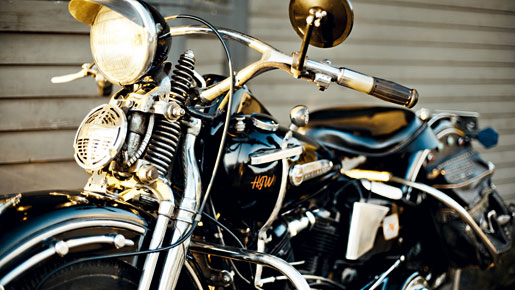
If you happen to be in Plainfield, NewHampshire sometime soon, and a 1952 Vincent Black Shadow drives past you in pristine condition, there’s no need to check the date on your watch, that would just be one of the many vintage bikes in Brian Keating’s collection. Keating is a master craftsman who has been collecting barn-find motorcycles and bicycles and restoring them back to road-worthiness for the past 30 years. Turning his passion into a business, he now runs the Keating Wheel Company, a family-run business, and like most family run businesses, it’s all a labour of love.
The early days of course were not easy, but like any collector, the thrill is in the find. Brian’s first projects consisted mainly of BMW’s slash two era machines, some R68s and some slash five models, as well as finding rare motorcycle memorabilia. He would buy-out struggling motorcycle dealerships in order to find vintage oil cans, literature, pins and signage. A lot of it would depend on the luck of the draw, and he is not without a few regrets. Items that were discarded at the time, such as “black and orange” new old-stock Harley-Davidson motorcycle parts are now extremely sought after and the motorcycle memorabilia that he has collected over the years has seen an unfortunate decline in interest.
Still, hindsight is a beautiful thing, and pursuing these unique items has been a great learning experience. As his eye for rare treasures developed he started to purchase the occasional old car, truck, boat or airplane engine. Transportation-related toys were a speciality, where cast-iron motorcycle toys made by Hubley, Champion, Vindex and others were dug out wherever they could, now making very collectible items. Brian would always buy from the originator, meaning he would buy the items that were out of circulation and then put them back into circulation, either through shows, swap meets or by advertising in publications. As his popularity grew, enthusiasts would call almost weekly just to see what new found treasures were in hand.
As the company gathered momentum Brian was able to put aside a little surplus money, which he used to purchase unrestored, original-paint American motorcycles, long before they became as popular as they are today. His reputation for getting unrestored, original-condition motorcycles up-to-speed became his trademark and this ethos still stands today. Very rarely are the motorcycles given an aesthetic makeover; keeping the unrestored originals at their best is the aim of the Keating Wheel Company, one that has become harder as the models become more difficult to locate − and afford − in today’s competitive market.
The art of finding rare models in a condition where they can be made road-worthy can be a frustrating business and there have been many highs and lows. What has kept the interest level high is changing focus between different racing machines, from early pedal start bikes (1900-1915), to Harley-Davidsons, to Indian, then on to European machines and so on. At one point, he tried focusing just on Harley-Davidsons and had a collection of Panheads circa 1948-1965, all in original paint. It was an honest pursuit to focus on one brand and do it well, but in the end it got too repetitive. A lesson was learned: his passion for all makes and models continued.
Over the years the Keating Wheel Company has acquired a great reputation with national institutions, selling motorcycles to the Harley Davidson Archives, J+P Cycles, Barbers Dairy and the Wheels Through Time Museum, as well as the newly-opened Motorcyclepedia Museum, which has many old motorcycles in its collection. Presently, Brian has just picked up his first ever Hot rod. It was built in 1959 and drag-raced, but has been off the road since the early 1960s. It’s rusty and crusty, just the way he likes them. He’s knee deep into it and loving every minute.
Getting these historic models back on the road is the reason Brian gets out of bed in the morning. It’s a dedicated vocation, one that comes with a little bit of pain, but always ends with pleasure when a vehicle that hasn’t been on the road in 50 years revs its engine. “That’s my speciality, that’s what we do best. You never know what is behind that closed door, but we’re always looking and opening them up”, he says. Keating Wheel Company is very much a family-run business; without the support of his wife and two kids, Brian says the company would not be where it is today. He hopes to continue doing this for many years and if the models keep coming out as gleaming as they do now, we hope so too.

